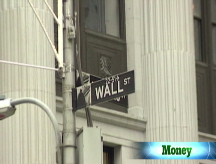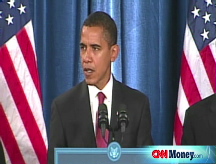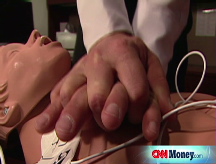Bailouts: $7 trillion and rising
Every day brings more news about the government's efforts to fix the economy. Here is how the plans are taking shape.
NEW YORK (CNNMoney.com) -- The U.S. government is now willing to spend more than $7 trillion to help rescue the economy. That's about $23,000 for every American, and more than half of U.S. annual gross domestic product.
It's a staggering and unprecedented amount of money. The last time the government went on a spending spree to cure a crisis was in the late 1980s and 1990s during the savings and loan crisis. But the $160 billion ($237 billion in today's dollars) it spent then comes nowhere close to what's being spent now.
But it may not be as bad as it seems: A substantial portion of that $7 trillion is investment, the government hasn't spent close to the total allotment yet, and the taxpayer may come out on top in the end.
"It's a lot of money, but it's not like it's out the door, never to be seen again," said Dean Baker, co-director of the Center for Economic and Policy Research. "A lot will be lost, but we're not going to lose anywhere close to $7 trillion."
The government has invested about $3 trillion of the total allotment, and it has already received much of that investment back. For instance, the Fed has gotten back about $1.2 trillion of the $1.6 trillion it has lent banks in its ongoing Term Auction Facility.
The government collects interest on its loans and when it takes an equity stake in a company or takes hold of an asset-backed security, those holdings could mature in value over the duration of the government's possession of them.
"At the end of the day, it's an expensive plan, but the government had to step in," said John Silvia, chief economist at Wachovia. "It's a difficult thing to estimate, but the government could sell the assets at a decent price once the market's better."
Furthermore, some of the $7 trillion will likely never be spent. The government can spend up to $1.4 trillion in purchases of short-term business debt under the Fed's Commercial Paper Funding Facility, but so far it has spent just $270 billion on the program.
Pessimists say the government is spending too much, putting taxpayer dollars at risk. Some say, that for all the government has spent, the results don't match the actions.
But optimists argue that much of the bailout serves as a guardrail, preventing the financial system from falling into a total collapse. And most economists argue that the cost of not acting would be far greater.
"We're doing this to prevent a financial collapse," said Baker. "Not acting would be much worse, because the financial system would grind to a halt."
More bailout measures still may be coming, as economists say the serious problems facing financial institutions have not yet subsided.
"More banks will likely fail, and I wouldn't be surprised if the FDIC has to go to Congress to get recapitalized," said Baker. "There's lots more bad debt that has yet to show up."
There's also a growing chorus of voices outside of Treasury to spread bailout money around.
The recent struggles of GM (GM, Fortune 500), Ford (F, Fortune 500) and Chrysler have built momentum for a bailout of the U.S. auto industry. Automakers have until Dec. 2 to submit proposals for how they would use - and pay back - $25 billion of government funding. The Bush administration has said it does not want a Detroit bailout to come from TARP funds.
Some government officials like FDIC Chair Sheila Bair have called for TARP money to be used to guarantee mortgages backed by private lenders to encourage them to restructure loans to troubled homeowners.
And President-elect Barack Obama has stated his support for another economic stimulus package in the form of tax rebates to consumers, states and municipalities. Economists believe the bill will cost about $500 billion. The proposal has gained traction in Congress, with hopes that consumer spending and aid to governments will help boost the economy.
Here is how the government has thus far invested billions of dollars to rescue banks, companies, consumers and their homes.
The government has taken these steps to aid financial institutions.
Term-auction facility: $1.6 trillion in loans to banks so far in exchange for otherwise unwanted collateral. The Fed increased its monthly auction limit to $300 billion in October, up from $20 billion when the Fed began the program.
Dollar swap lines: Unlimited dollars to 13 foreign central banks to provide liquidity to foreign financial institutions. The Fed lifted its cap after raising it to $620 billion in October from $24 billion in December.
Bear Stearns: $29 billion in a special lending facility to guarantee potential losses on its portfolio. With the lending facility, JPMorgan was able to step in to save Bear from bankruptcy.
Lending to banks: $70 billion lent on average every day to investment banks, after facility opened to non-commercial banks for first time in March. $92 billion a day to commercial banks.
Cash injections: $250 billion allocated to banks from $700 billion rescue package in exchange for equity stake in the financial institutions in the form of senior preferred shares.
Citigroup: $300 billion in troubled asset guarantees and $45 billion in cash-injections to prevent fourth-largest bank from failing.
Fed rate cuts: Down to 1% in October 2008, from 5.25% in September 2007.
Consumers are benefiting from the government's actions in recent months.
Stimulus checks: $100 billion in stimulus checks made their way to 140 million tax filers to boost consumer spending and help grow the economy.
Unemployment benefits: $8 billion toward an expansion of unemployment benefits, to 39 weeks from 26 weeks. Some states must now offer 39-week benefits after an extension act was passed in November.
Bank takeovers: $15.5 billion drawn down so far from the FDIC's deposit insurance fund after 22 bank failures in 2008.
Rehab foreclosed homes: $4 billion to states and municipalities in assistance to buy up and rehabilitate foreclosed properties.
Student loan guarantees: $9 billion so far in government purchases of student loans from private lenders. Higher borrowing costs made student loans unprofitable for a number of lenders, many of whom stopped issuing the loans.
Money-market guarantees: $50 billion in insurance for money-market funds. The Fed then began to lend an unlimited amount of money to finance banks' purchases of debt from money-market funds. The Fed then agreed to purchase up to $69 billion in money-market debt directly. In October, the Fed said it would loan up to $600 billion directly to money-market funds, which was extended for six months in November.
Housing rescue: $300 billion approved for insurance of new 30-year, fixed-rate mortgages for at-risk borrowers. The bill includes $16 billion in tax credits for first-time home buyers. But lenders have been slow to sign on.
Deposit insurance: $250,000 in insurance for interest-bearing accounts, up from $100,000. The FDIC also issued unlimited guarantees on non-interest- bearing accounts and newly issued unsecured bank debt.
Consumer loans: $800 billion extended to consumer loan-backed securities, including $200 billion for assets backed by credit cards and car loans and $500 billion in mortgage-backed securities. The Fed will also buy $100 billion of Fannie Mae and Freddie debt to try to make loans cheaper.
Uncle Sam has intervened to help companies in the following ways.
Business stimulus: $68 billion in tax breaks to corporations to help loosen the stranglehold on businesses trying to finance daily operating expenses.
Fannie Mae, Freddie Mac: $200 billion to bail out the mortgage finance giants. Federal officials assumed control of the firms and the $5 trillion in home loans they back.
AIG: $152.5 billion restructured bailout, including a direct investment through preferred shares, a easier terms on a $60 billion loan, and new facilities meant to take on the companies exposure to credit-default swaps.
Automakers: $25 billion in low-interest loans to speed the industry's transition to more fuel-efficient vehicles.
Commercial paper facility: $271 billion in corporate debt purchased so far by the Fed since its so-called Commercial Paper Funding Facility opened. The Fed allocated $1.4 trillion for the program. ![]()




